Understanding Gnats: Impact on Garden Health
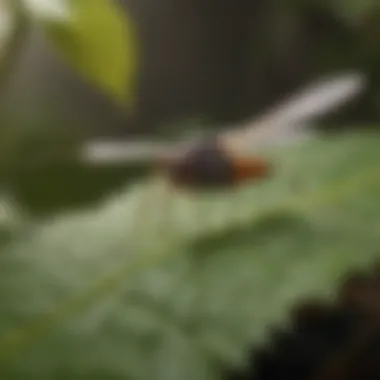
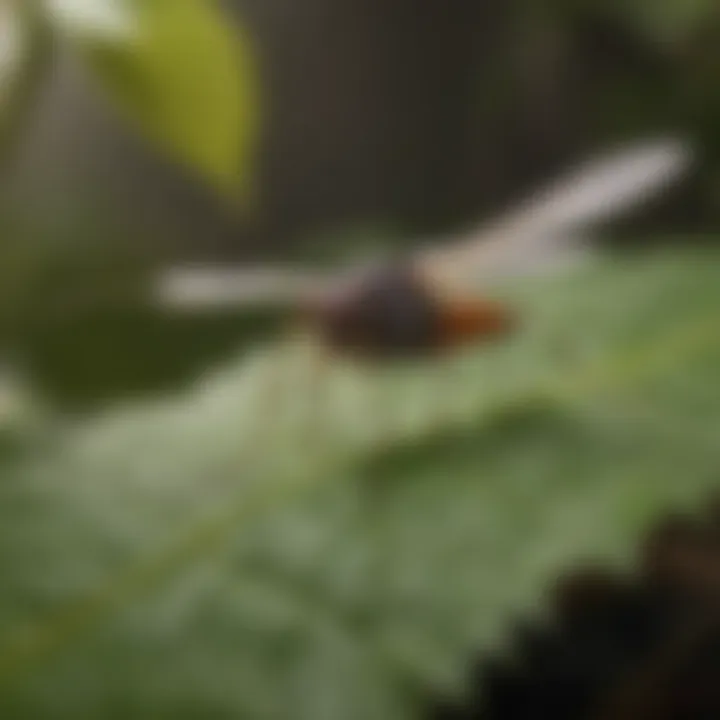
Intro
Gnats are small, flying insects that can cause significant issues for gardeners and plant enthusiasts. Often dismissed as minor nuisances, their presence can indicate underlying problems in both indoor and outdoor gardening contexts. Understanding the biology and behavior of these pests is crucial for effective management and prevention. This article will explore various aspects of gnat infestations, including their impact on plant health and effective gardening practices that can mitigate their effects.
In the following sections, we will delve into the types of gnats commonly found in gardens and the damage they can inflict on plants. Additionally, we will discuss practical strategies for prevention and responsible pest control. By integrating this knowledge, gardeners can enhance their cultivation practices and safeguard their plants from potential harm.
Types of Gnats in Plants
Gnats can be broadly categorized into several species that commonly infest gardens, such as:
- Fungus Gnats: These are the most prevalent types found in houseplants. They thrive in moist conditions, laying their eggs in rich, organic soil. The larvae feed on plant roots, leading to weakened plants.
- Black Fungus Gnats: Similar to common fungus gnats but with darker coloration. They tend to occupy similar habitats and exhibit similar damaging behaviors to plants.
- Fruit Flies: Often attracted to overripe or decaying fruits and vegetables, these gnats can also infiltrate indoor spaces and damage plants nearby.
Each of these species has unique behaviors and habitats, influencing how they interact with various plants.
The Impact of Gnats on Plant Health
The presence of gnats signifies not only discomfort but also a potential risk to plant health. Key impacts include:
- Root Damage: Gnat larvae primarily feed on roots, resulting in stunted growth and increased susceptibility to diseases.
- Nutrient Deficiency: Damage to root systems can limit a plant's ability to absorb necessary nutrients from the soil.
- Overall Plant Stress: Infestations can lead to wilting, yellowing leaves, and poor growth, ultimately reducing the plant’s resilience.
It is important for gardeners to be vigilant about the presence of these pests to act promptly.
Prevention Strategies
Preventing gnat infestations begins with creating an unfavorable environment for these pests. Consider the following practices:
- Watering Practices: Overwatering should be avoided. Allow the top layer of soil to dry out before resuming watering to deter gnat larvae.
- Soil Management: Use well-aerated, fast-draining soil to minimize moisture retention, reducing breeding conditions for gnats.
- Proper Sanitation: Remove decaying plant material and clean up spilled soil to reduce attractive breeding grounds.
- Natural Predators: Introduce beneficial insects, like predatory nematodes, which can help keep gnat populations in check.
Management Techniques
If an infestation occurs, several management techniques can be adopted:
- Traps: Sticky traps can be placed near affected plants to capture adult gnats. Yellow sticky traps are particularly effective.
- Insecticidal Soap: Spraying affected plants with insecticidal soap can help manage both adult and larval stages of gnats.
- Neem Oil Treatment: Neem oil acts as a natural pesticide to combat gnat infestations. It disrupts the lifecycle of pests when applied to the soil and plants.
A proactive approach is always preferred over a reactive one when addressing gnat infestations.
Synthesizing Knowledge
Understanding gnats in the context of gardening is essential for maintaining plant health. By recognizing the types of gnats, their impacts, and employing prevention and management strategies, individuals can foster a thriving garden environment. Whether in a home garden or indoor plants, informed gardening practices play a vital role in mitigating the effects of these pests.
Intro to Gnats
Gnats are small, flying insects that often find their way into gardening spaces, becoming a common source of concern for those who cultivate plants. Understanding these pests is crucial because they can significantly affect both the health of plants and the overall productivity of gardening efforts. By becoming familiar with gnats, gardeners can implement preventive strategies to minimize potential infestations, saving time and resources.
Defining Gnats
Gnats belong to several families within the order Diptera. They are generally characterized by their small size and slender bodies. Most people recognize them by their swarming behavior, particularly in moist areas. Gnats typically measure between one to five millimeters in length and can be tan, gray, or black in color. Their life cycle consists of several stages: egg, larva, pupa, and adult, each of which can have implications for gardening.
Gnats are commonly categorized into different types, such as fungus gnats and fruit flies. Fungus gnats lay their eggs in soil, particularly in damp conditions, while fruit flies are attracted to rotting fruits and vegetables. This distinction not only helps in identifying them but also in applying appropriate control measures.
Gnats versus Other Insects
Unlike other garden pests like aphids or spider mites, gnats are often more of a nuisance than a direct threat to plant health. However, their presence indicates that environmental factors may not be ideal, especially in terms of moisture levels. Some insects, like beetles and caterpillars, can cause significant physical damage to plants, while gnats primarily pose indirect risks.
Understanding the behavioral patterns of gnats can assist in formulating effective gardening practices.
While some gnats may not directly feed on plant tissues, they can introduce pathogens and diseases to plants. This transmission can lead to secondary infestations, complicating pest management efforts. Therefore, complimentary pest identification and understanding their roles can enhance a gardener's approach to mitigating infestations. By recognizing the differences between gnats and more destructive insects, gardeners can better tailor their management practices, protecting their plants and ensuring healthier growth.
Types of Gnats Found in Plants
Understanding the various types of gnats that can infest plants is crucial for gardeners. Knowledge of these species allows for targeted management practices and improved plant health. Each type of gnat interacts with both the plants and their environment differently, which influences their presence and impact. By identifying these specific types, gardeners can implement effective prevention strategies and control measures that address the unique characteristics of each gnat species.
Fungus Gnats
Fungus gnats are small, dark insects commonly found in houseplants and garden soil. They prefer damp conditions, often making overwatered soil their ideal habitat. The adults are more of a nuisance than a direct threat, but their larvae feed on the roots of plants, which can lead to serious damage.
The larvae of fungus gnats live in the soil and feed on organic matter, fungus, and plant roots. This feeding can stunt plant growth, cause wilting, and, in severe cases, result in plant death. To manage these gnats, gardeners can allow the soil to dry out between waterings. Additionally, incorporating sand or perlite on top of the soil can discourage the gnats from laying eggs.
Fruit Flies
Fruit flies are another type of gnat that can impact plants, especially when growing fruits or vegetables. These flies are attracted to ripening or fermenting organic matter. They are not as harmful as fungus gnats, but they can still pose problems by laying eggs on ripe fruits and vegetables, leading to larvae development.
For gardeners growing fruits or vegetables, monitoring for fruit flies is essential. Maintaining cleanliness, removing overripe or rotting produce, and using traps can help manage these pests. This minimizes their presence and prevents them from causing any significant damage to the crops.
Black Gnats
Black gnats, though less commonly discussed, can also inhabit gardens. These insects are characterized by a darker appearance and are typically associated with moisture-rich areas. Black gnats can be particularly bothersome in large groups. While they do not cause direct harm to plants, their high populations can be an indicator of underlying issues such as excessive moisture or poor soil drainage.
To manage black gnats, gardeners should assess their watering practices and ensure proper soil drainage. Addressing the underlying environmental factors can reduce their numbers significantly. By maintaining a balanced environment, black gnats can be kept at bay, thereby supporting healthier plant growth.
Life Cycle of Gnats
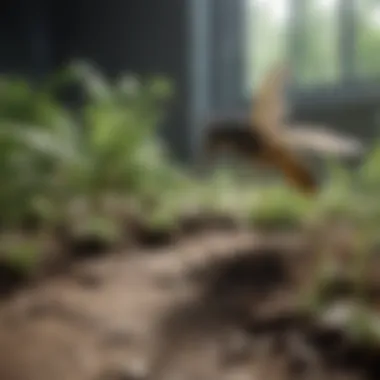
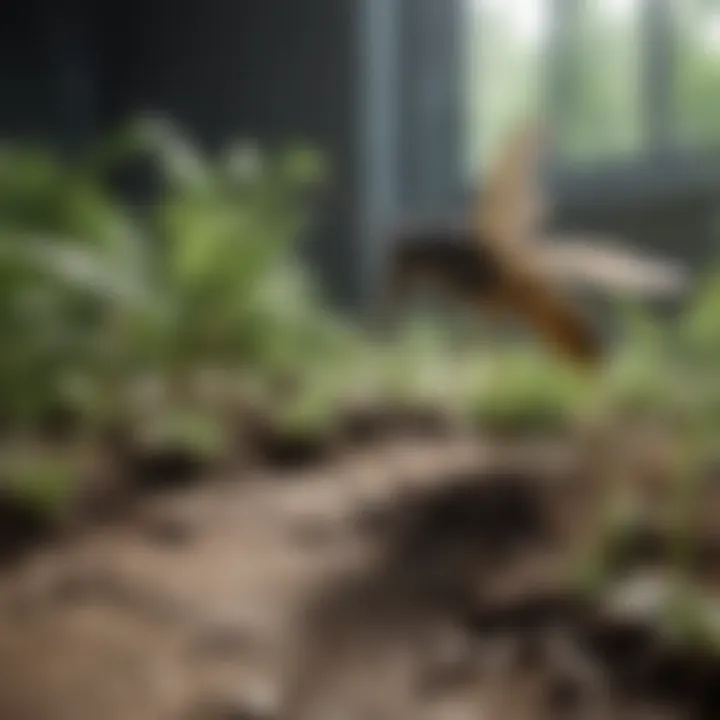
The life cycle of gnats is crucial to understand when tackling gnat infestations. Knowing each stage helps gardeners identify the most effective management strategies. Gnats typically undergo a complete metamorphosis, and each life stage has unique characteristics and vulnerabilities. Recognizing these stages enables proactive measures, ultimately reducing the impact on plant health.
Egg Stage
The egg stage marks the beginning of a gnat's life. Female gnats lay eggs in moist environments, often in the soil of potted plants or in decaying organic matter. One female can deposit hundreds of eggs at a time, which is why infestations can escalate quickly.
Eggs are small and usually white or translucent, making them difficult to spot. It typically takes about four to ten days for the eggs to hatch, depending on environmental conditions. Understanding the duration of this stage is essential. If gardeners notice an increase in adult gnat populations, they should remember that it may be due to recent egg-laying activities.
Larval Development
Once the eggs hatch, the larvae emerge. Gnat larvae are small, often 1/8 to 1/4 of an inch long, and they thrive in wet, organic environments. They feed on decaying plant material, fungi, and roots, which can lead to weakened plants. This stage is critical as it directly impacts plant health; heavy feeding can cause stunted growth or even death in young plants.
During the larval phase, which lasts about two to three weeks, the larvae grow and molt several times. This part of the life cycle can be targeted through cultural practices. For example, allowing the top layer of soil to dry out can help reduce larval survival rates.
Adult Stage
The adult stage of gnats is familiar to most gardeners. Adults are typically small, flying insects, about 1/16 to 1/8 of an inch long. They are often seen hovering around plants or light sources. Adults emerge from the soil or the environment where they pupated, signaling a new cycle of egg-laying.
The lifespan of an adult gnat can vary, ranging from a few days to several weeks. Their reproductive potential during this time is significant. Thus, a small number of adults can lead to a rapid increase in the population if left unmanaged. Monitoring and promptly addressing adult gnats is essential for effective pest management.
Understanding the life cycle of gnats aids gardeners in implementing timely interventions, ensuring healthier plant growth.
By recognizing these life stages and their implications, gardeners can become proactive rather than reactive in their pest management practices. This knowledge is critical for sustaining a healthy garden environment.
Habitat Preferences of Gnats
Understanding the habitat preferences of gnats is critical for gardeners and plant enthusiasts. Knowledge in this area can lead to effective preventive measures against infestations. By recognizing the environments that favor gnat populations, strategies can be employed to minimize their presence in gardens and homes.
Moisture-Rich Environments
Gnats are often found in moisture-rich environments. These insects thrive in areas where humidity levels are high and soil remains damp. This is particularly evident in potted plants, where excess water can create a favorable breeding ground for gnats. The larvae of fungus gnats, for instance, require moist conditions to survive and grow. Additionally, overwatering can lead to stagnant water, which is even more appealing to gnats. For homeowners, it is crucial to monitor watering schedules and ensure that pots have adequate drainage to prevent water accumulation.
- Key Factors: High humidity, damp soil, stagnant water.
- Solutions: Adjust watering schedules, enhance drainage systems.
Role of Soil Quality
Soil quality plays an essential role in gnat infestation. Poorly managed soil can contribute to the presence of organic matter that provides nourishment for gnat larvae. When soil is rich in decaying matter or lacks proper aeration, it can create an ideal condition for these pests. This emphasizes the importance of using quality soil and regularly aerating the potting mix.
Regularly checking the condition of the soil can help identify gnat issues before they escalate. If gardeners notice an increased gnat presence, it may be beneficial to amend the soil or replace it entirely. Organic options, such as using compost or beneficial nematodes, can enhance soil quality while simultaneously preventing gnat infestations.
- Considerations: Organic matter presence, soil aeration.
- Best Practices: Regularly assess soil quality, utilize organic amendments.
"Maintaining optimum soil quality and moisture levels are keys to preventing gnat infestations in your gardening spaces."
Impact of Gnats on Plant Health
Understanding the impact of gnats on plant health is vital for any gardener. Gnats can significantly affect both the physical condition of plants and their overall vitality. This section elucidates the specific ways in which gnats inflict damage and highlight the importance of recognizing these issues early.
Direct Damage to Plants
Gnats often cause direct damage to plants, primarily through their larval stage. Fungus gnat larvae, for instance, feed on plant roots. This feeding behavior can lead to root rot, stunted growth, and ultimately, plant death. The roots are critical for the plant’s overall health, as they are responsible for nutrient and water absorption.
Additionally, adult gnats can sometimes feed on the foliage, particularly when populations are large. This may result in irregular patches or discoloration on leaves, which can make the plants more vulnerable to other pests and diseases.
Signs of direct damage may include:
- Wilting leaves despite adequate moisture in the soil.
- Yellowing or browning of leaf edges.
- Stunted growth or a lack of vigor in growing plants.
It is essential for gardeners to regularly monitor their plants for signs of gnat activity and the associated damages to intervene promptly if they notice any issues.
Transmission of Diseases
Beyond direct damage, gnats are vectors for various plant diseases. They can facilitate the transmission of pathogens such as fungi and bacteria, which can lead to more serious health problems in plants. For example, the movement of fungal spores can result in infections that could otherwise be prevented.
The implications of disease transmission are considerable. Diseases like root rot or leaf spot can decrease plant health and yield and may require more aggressive control measures to manage. Gardeners must be aware that the presence of gnats on any plant indicates a potential risk for disease.
“Preventing gnat infestations is not just about reducing numbers; it’s about safeguarding plant health as a whole.”
Moreover, it is prudent for gardeners to practice good hygiene and plant care. Regular sanitation practices, such as removing decaying organic matter and ensuring potting soil is free from pathogens, can help in mitigating the negative impacts of gnats on plant health.
Identifying Gnat Infestations
Identifying gnat infestations is crucial for effective gardening. The early detection of these pests can significantly minimize their impact on plants. By recognizing the signs of an infestation, gardeners can implement remedial measures before the situation worsens. This proactive approach helps safeguard plant health and promotes a thriving garden.
Signs of Infestation
Detecting the presence of gnats in plants involves observing several key signs. Here are common indicators:
- Adult Flies: Noticing small, flying insects around plants is usually the first sign. Fungus gnats, for instance, are often seen around the soil surface.
- Larval Presence: Inspecting the soil may reveal tiny, larvae-like creatures. These are usually found in moist areas near the roots.
- Wilting Leaves: Plants suffering from gnat infestations might display wilting or yellowing leaves due to root damage.
- Soil Conditions: If the soil feels overly moist and compact, gnats are likely breeding in that environment.
Monitoring these signs can help gardeners maintain control over their space and achieve healthier plants.
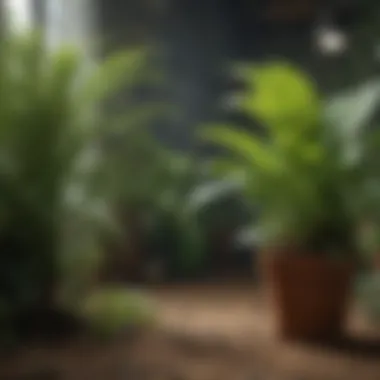

"Observation is the key; absence of flies doesn't mean absence of larvae."
Assessing Plant Damage
Assessing damage caused by gnats requires careful observation. Some damage may be visible immediately, while other effects develop over time. Consider the following when evaluating plant health:
- Root Examination: Carefully removing a plant from its pot can help identify root damage. Roots may appear blackened or mushy when affected by gnats.
- Soil Texture: Checking the soil texture is important. A soggy texture often indicates overwatering or excessive moisture, creating ideal conditions for gnat reproduction.
- Growth Patterns: Observe how the plant grows. Stunted growth or browning leaf tips can indicate stress and potentially link back to gnat activity.
Knowing these signs and understanding plant health are vital in ensuring effective gardening practices. Identifying infestations early can lead to better outcomes and a more resilient garden.
Preventive Measures for Gnats
The significance of preventive measures for gnats cannot be overstated. Healthy gardening practices focus on minimizing the conditions that support gnat proliferation. By addressing essential factors like soil management, proper watering practices, and environmental controls, gardeners can create an inhospitable environment for gnats. This approach not only protects plant health but also saves time and resources on dealing with infestations later.
Soil Management
Soil quality plays a vital role in deterring gnat populations. Gnats thrive in moist, organic-rich soils, making it crucial for gardeners to use well-draining soil mixtures. Adding perlite or sand can improve drainage, decreasing moisture retention. Additionally, avoid over-fertilizing, as excess nutrients can promote fungal growth, attracting fungus gnats. Implementing regular soil checks is advisable. If any signs of gnat larvae are noted, changing the soil can help eliminate the problem.
Watering Practices
Watering practices significantly influence gnat presence. Excessive moisture is often a precursor to infestations. Gardeners should adopt a "less is more" philosophy. Allowing the top inch of soil to dry before the next watering is universally beneficial. A moisture meter can help assess when to water. Furthermore, considering drip irrigation systems can prevent water pooling on surfaces, thus reducing gnat habitats.
Environmental Controls
Environmental conditions also contribute to the presence of gnats. Maintaining proper humidity levels is essential. Since gnats prefer humid areas, using fans can improve air circulation in indoor gardens and help keep humidity at bay. Outdoors, ensuring adequate spacing between plants can reduce humidity around foliage. Moreover, regularizing light exposure can discourage gnat proliferation.
Maintaining an environment that is less favorable for gnats significantly reduces the risk of infestations, fostering healthier plants and reducing pest management efforts.
By following these preventive measures—soil management, watering practices, and environmental controls—gardeners can effectively manage gnat populations before they escalate into larger infestations.
Management Strategies for Existing Infestations
Effective management of gnat populations is vital for maintaining the health of both indoor and outdoor plants. Ignoring gnat infestations can lead to significant plant damage and possibly the spread of diseases. This section outlines practical strategies to combat these pests. Each method presents unique advantages, allowing gardeners to choose the most applicable solution based on their circumstances. The aim is to create an integrated approach that minimizes gnat presence while safeguarding plant health.
Physical Removal Methods
One of the simplest ways to manage gnat populations is through physical removal. This includes methods such as:
- Manual Trapping: Individuals can make simple traps using vinegar, sugar water, or sticky paper. These traps attract gnats, reducing their numbers without the use of chemicals.
- Soil Tilling: Disturbing the top layer of soil can disrupt larval development providing a physical barrier to their growth.
- Flushing Soil: In instances of gnat infestations in potted plants, flushing the soil with water helps drown larvae. However, it's crucial to ensure that the plant can endure such treatment.
While these methods are generally safe and effective, repeated application may be necessary to keep the gnat population in check.
Natural Predators
Introducing natural predators can be an eco-friendly solution to gnat problems. Several organisms can help control gnat populations by predation:
- Beneficial Nematodes: These microscopic worms can be added to the soil, where they seek out gnat larvae and eliminate them. They are safe for plants and do not harm other living organisms.
- Predatory Insects: Certain insects, like Hypoaspis miles, feed on gnat larvae. Their presence can greatly reduce the gnat population.
Utilizing natural predators not only reduces the gnat problem but also ensures the health of the ecosystem. However, it is important to research the specific needs of these beneficial organisms to ensure their effectiveness.
Chemical Control Options
Chemical control should be considered a last resort due to potential toxicity to plants, pets, and humans. However, in severe cases of infestation, certain products can be effective:
- Insecticidal Soap: This option targets the soft-bodied larvae without causing significant harm to the plant. It works by suffocating the pests and can be applied directly to affected areas.
- Pyrethrin-Based Insecticides: These products derived from chrysanthemum flowers, are effective against adult gnats. While they can eliminate adult populations quickly, careful application is essential to minimize harm to beneficial insects.
- Bacillus thuringiensis israelensis (Bti): This biological control method targets gnat larvae specifically and is considered safe for plants and pets.
Proper usage and adherence to instructions on all products are paramount to achieving effective results.
"Integrating multiple strategies can provide a more comprehensive approach to gnat management, ensuring both immediate effects and long-term solutions."
Through a combination of physical, natural, and chemical methods, gardeners can effectively reduce gnat populations. Constant monitoring and assessment of the infestation will allow for adjustments and improvements in strategy, thus providing a balanced and sustainable gardening environment.
Long-Term Management of Gnat Populations
Effective management of gnat populations is essential for sustaining healthy plants and minimizing damage in both indoor and outdoor gardening. Gnats, while often overlooked, can lead to significant issues if left unchecked. Understanding and implementing long-term strategies can greatly enhance a gardener's success. Here, we delve into the importance of this topic, outlining several key elements, benefits, and considerations for managing gnat populations over time.
The key to managing gnats lies in an integrated approach that combines observation, prevention, and control. It is not just about eliminating the visible pests but addressing the underlying conditions that allow them to thrive. Environment plays a crucial role here. Addressing humidity, watering practices, and soil composition can reduce gnat breeding. By altering the desired conditions, one can make the environment less attractive for gnats to reproduce.
Integrated Pest Management Approaches
Integrated Pest Management (IPM) is a holistic approach that combines different strategies to manage pests like gnats effectively. This method relies on understanding the life cycle and behavior of gnats to implement tailored actions. Here are some critical elements of an effective IPM strategy:
- Monitoring: Regular inspection of plants helps identify early signs of gnat activity. Sticky traps can be useful for capturing adult gnats.
- Prevention: Focus on creating unfavorable environments for gnats. This includes improving air circulation and employing proper watering techniques to prevent moist conditions that gnat larvae favor.
- Control Measures: Utilize biological control methods, such as introducing beneficial nematodes or predatory insects that target gnat larvae.
- Chemical Options: As a last resort, consider using organic pesticides that are specifically formulated to target gnats without harming beneficial insects.
Implementing IPM can reduce reliance on chemical products while maintaining effective pest control. By understanding the pest's habits, gardeners can create a less hospitable environment for gnats.
Monitoring and Assessment
Vigilant monitoring and assessment are crucial in managing gnat populations. Consistent observation can help detect problems before they escalate. Here are key aspects to consider for effective monitoring:
- Regular Plant Inspections: Observing plants for any signs of gnat activity or damage helps catch infestations early.
- Use of Traps: Setting up yellow sticky traps can also provide insights into the gnat population's size and effectiveness of control strategies.
- Soil Checks: Regularly evaluate the composition and moisture of the soil. Soil that remains consistently wet can promote gnat breeding.

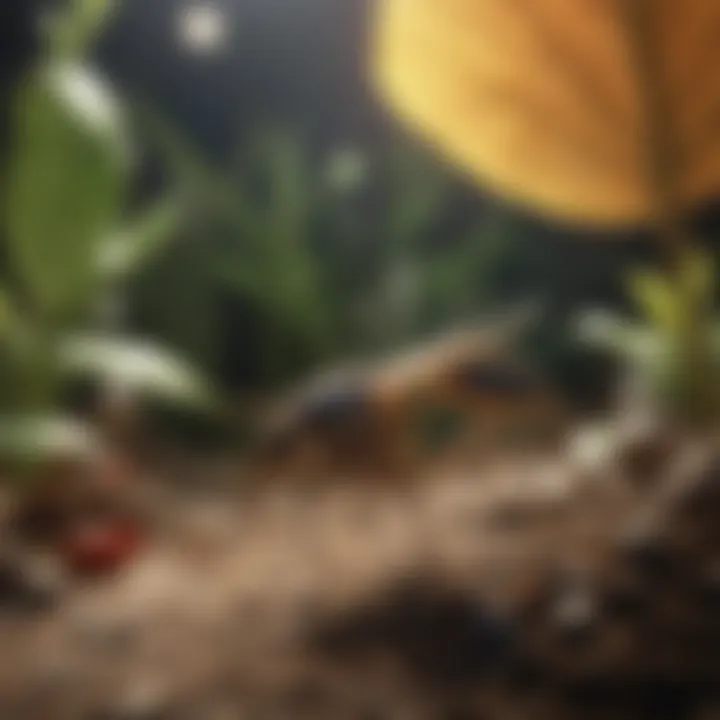
Establish a routine for monitoring, which may include tools such as journals or digital tracking systems. This will allow for thoughtful assessment of gnat population trends over time. Documentation provides insights into the effects of applied management techniques, enabling ongoing adjustment of strategies as needed.
"An ounce of prevention is worth a pound of cure" takes on new meaning when it comes to managing gnats.
Case Studies in Gnat Control
Successful Management Techniques
In managing gnat populations, various strategies have been employed with different levels of success. Case studies provide invaluable insights into what methods are effective and how the findings can be applied in other gardening situations. One notable example is the use of biological control agents, like the introduction of beneficial nematodes. These microscopic roundworms target gnat larvae in the soil, drastically reducing their numbers without harming plants or non-target organisms.
Another effective technique reported involves the careful monitoring of moisture levels in soil. A case study from a commercial greenhouse highlighted how adjusting watering practices not only lessened gnat populations but also improved the overall health of plants. The integration of sticky traps further helped in monitoring adult gnat numbers while minimizing the impact on the plants themselves.
Utilizing companion planting has also been shown to reduce gnat infestations. For instance, planting marigolds alongside susceptible plants repels gnats. This method was documented in several urban gardens and showcased how leveraging natural relationships in plant life can yield substantial benefits in pest management.
These management techniques emphasize that understanding specific environmental conditions can improve pest control protocols. Every garden is unique, hence, future strategies must evolve based on localized results.
Lessons Learned
From the various case studies presented, several lessons emerge that are critical for effective gnat control. Firstly, consistent monitoring of both gnat populations and plant health is key. This can lead to early detection of infestations, allowing for prompt responses to limit damage.
Secondly, the importance of integrating multiple control methods cannot be overstated. Relying solely on chemical treatments can lead to resistance and environmental harm. Many successful case studies reveal that biological and cultural controls often yield better long-term results when used in conjunction with chemical methods.
The significance of education and awareness among gardeners is another crucial takeaway. Workshops and information sessions can empower homeowners to better recognize and manage gnat issues. Increased knowledge sharing fosters community resilience against pests.
Finally, adaptability stands out as a prominent lesson. As conditions change—whether through climate shifts or changes in plant selection—so too must the approaches to gnat management. Those who remained flexible in their strategies reported higher success rates than those who adhered strictly to one method. With clear examples to guide future practices, the collective knowledge from these case studies will inform a more stable approach to controlling gnats in various environments.
Common Misconceptions About Gnats
Understanding the common misconceptions about gnats is integral to managing them effectively in gardening practices. These small insects are often dismissed as insignificant pests, leading to inadequate responses when an infestation occurs. Many homeowners and gardening enthusiasts assume that all gnats are equally harmful to their plants, undermining the reality of their diverse roles within ecosystems. By unpacking these misconceptions, one can cultivate a more informed approach.
Are All Gnats Harmful?
One prevalent belief is that all types of gnats pose a threat to plant health. This is an oversimplification. While it is true that some species, like fungus gnats, can damage root systems and hinder plant growth, others like gall gnats, play a neutral or even beneficial role.
- Fungus Gnats are often the primary concern. They thrive in damp soil and their larvae feed on organic matter and roots, leading to stressed plants.
- Conversely, non-harmful gnats contribute to the breakdown of organic materials, enhancing soil health.
Thus, distinguishing between harmful and harmless gnats is essential. Not all gnats are pests; some can be harmless or beneficial, helping to maintain a balance in the garden environment.
The Role of Gnats in the Ecosystem
Gnats, while often viewed simply as nuisances, fulfill multiple roles in the ecosystem.
- Pollinators: Some gnat species contribute to the pollination of plants, participating in the reproductive cycles of various flowering species.
- Detritivores: Many feed on decaying plant material, assisting in decomposition and nutrient recycling.
- Food Source: Gnats serve as prey for numerous birds and beneficial insect species, forming an integral part of the food web.
"The presence of gnats in the garden should not be viewed solely through the lens of pest control but as a component of ecological balance."
This understanding highlights the complexity of pest management strategies. Instead of eradication, promoting a balanced ecosystem that includes beneficial gnats can enhance all aspects of plant health.
Practical Advice for Gardeners
Understanding gnats and their impact on gardening requires taking strategic measures. This knowledge allows gardeners to tailor their practices effectively. Practical advice encompasses a range of tactics to mitigate gnat populations while enhancing plant health. Through informed decisions, the experience of gardening becomes rewarding and less stressful.
Choosing the Right Plants
Selecting suitable plants can significantly reduce the chances of gnat infestations. Some plants naturally deter these pests. For example, the use of herbs like basil and mint can create an environment less conducive to gnat survival. Considerations in plant selection should include:
- Drought Resistance: Plants that require less water are typically less attractive to gnats. This is because excessive moisture in the soil provides ideal breeding grounds for gnats.
- Native Species: Growing native plants can lead to better overall plant health and resilience against pests. These species are often adapted to local conditions, making them less vulnerable to gnat infestations.
- Soil and Root Health: Choose plants known for their robust root systems. Strong root systems can help plants resist the negative impacts of gnat larvae.
Choosing wisely provides a dual benefit. It not only supports the garden’s ecosystem but also minimizes the need for additional pest control measures.
Seasonal Considerations
The attention to seasonal changes is critical in managing gnat populations. Each season impacts plant growth and gnat behavior, creating opportunities for gardeners to adapt their practices. Consider the following points:
- Spring: This is often the peak period for gnat activity, due to increased warmth and moisture. During this time, maintain dry soil conditions.
- Summer: High humidity can promote gnat reproduction. Regular inspections for early signs of infestations should be routine.
- Autumn: As temperatures cool, reducing watering can help weaken gnat populations preparing for winter.
- Winter: Indoor plants can also attract gnats. Keeping indoor environments less humid while implemented pests controls is advisable.
By aligning gardening practices with seasonal patterns, one can effectively diminish the likelihood of gnat problems in a more sustainable manner.
Culmination
In summary, understanding gnats in plants is crucial for effective gardening practices. This article has outlined the serious implications these pests can have on plant health and overall garden aesthetics. By acknowledging the various types of gnats, their life cycles, and habitat preferences, homeowners and gardening enthusiasts can develop informed strategies to combat infestations.
Key Considerations:
- Recognizing the signs of gnat infestations early can prevent larger problems later.
- Implementing preventive measures such as proper soil management and environmental controls plays a vital role in managing gnat populations.
- Utilizing integrated pest management approaches can are beneficial for long-term control and sustaining plant health.
The exploration of common misconceptions about gnats also sheds light on their ecological roles, emphasizing that not all species are detrimental. Understanding these facts enables gardeners to foster a healthier ecosystem within their gardens.
Ultimately, the information presented serves as a comprehensive guide that empowers gardeners to take charge of their gardening practices, potentially saving them time, money, and frustration. Armed with the right knowledge and strategies, gardeners can maintain their plants effectively, even in the presence of gnats.
Importance of References
- Credibility: Citing reliable sources enhances the authority of the article. Research findings from reputable organizations or studies lend weight to the claims about gnats and their impact on gardening practices.
- Further Reading: Readers are motivated to seek out more information through references. This encourages a deeper understanding of the topic and leads to informed gardening practices.
- Intellectual Honesty: Properly attributing ideas protects against plagiarism. It acknowledges the contributions of previous researchers and experts in the field.
- Connection to Broader Research: References can connect readers to a wider body of research that encompasses not just gnats but also pest management and ecology.
Considerations for Effective References
- Use of diverse sources, including academic journals, expert blogs, and practical gardening sites can enrich the article.
- Ensure all sources are current and relevant to the topic, providing the most accurate information available.
- Highlight any local or specific studies that address gnat problems, as regional factors can significantly influence gardening practices.







